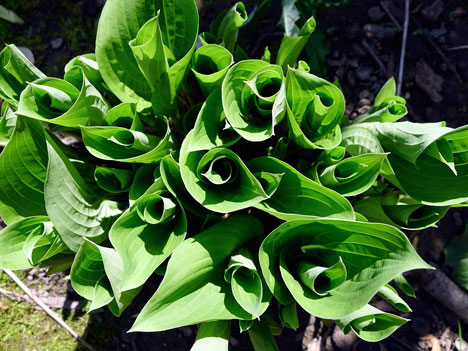
once again this year, i’m spending most of the month of april away from home. it’s a time of great change in the yard and garden, though still too early and cold to plant or to work outside for very long, most days.
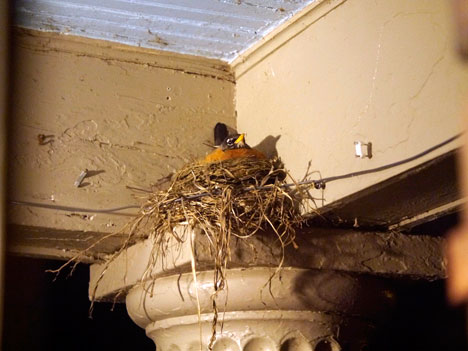
i found this picture in the camera while downloading the photos from our sticks and stones shoot—david must have gotten up on a box inside the entry hall to aim the camera out the window at the robin’s nest.
it’s adorable . . .
and that reminded me that i wanted to check on the dove’s nest as well—i wondered how her hatching was progressing.
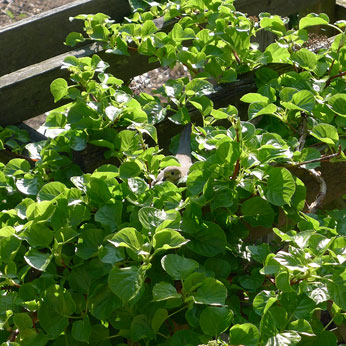
she’s still at it, dead center of the photo, though the greenery has grown up all around her to provide even better camouflage.
(excuse the square photos; i inadvertently moved the aspect setting on the camera without realizing it and got a series of square pictures instead of rectangular ones. variety is the spice of life, right?)
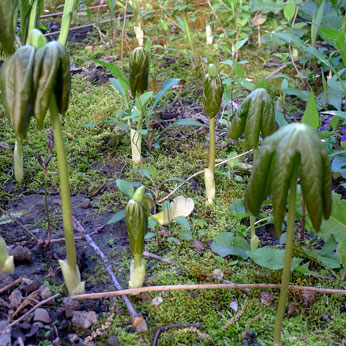
my times at home between trips are often filled with catching up on desk work, but i took a few breaks this week to get outside and shoot some photos. i like to have a photo record of each year’s progress to remind me when the plants emerged, bloomed, and died back.
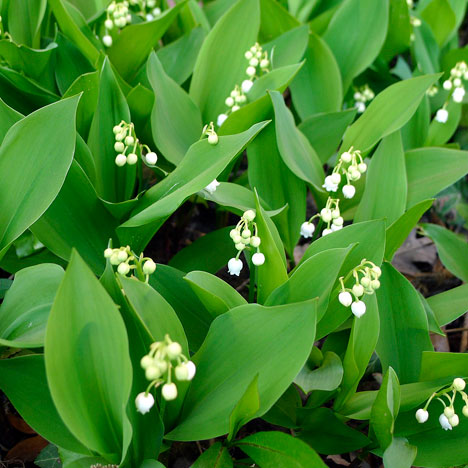
the exciting news as i write this is that the lily of the valley is opening up—by the time you read this, they will all be open and a heavenly scent will fill the back yard, where whole swaths of them are growing. it is totally better than grass . . . i thought the event deserved a slightly bigger size photo, haha.
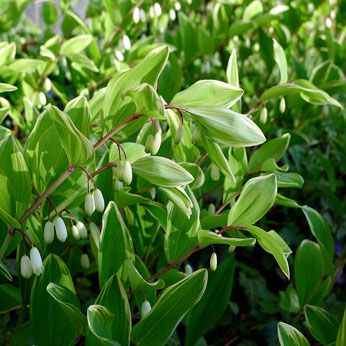
next to the LOV, the variegated solomon’s seal is blooming—we have lots of this too; it loves living and propagating in our yard.
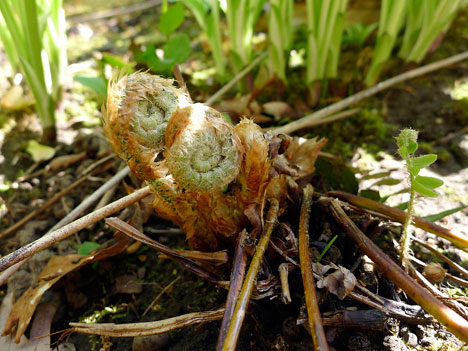
the fiddleheads that were so tightly wound the last time i checked have begun to open and raise their little heads up—they remind me of baby chicks at this stage.
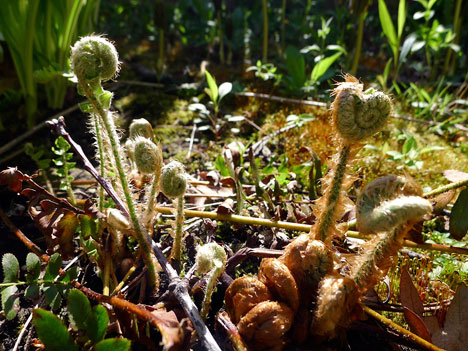
or snails on a stick??
(ok, just pretend i didn’t say that)
i have some beautiful ferns in the back garden and i wouldn’t mind collecting some of the more unusual types. for instance these autumn ferns
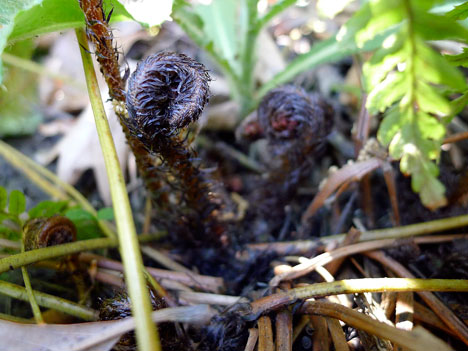
they look like a swamp creature, don’t they?
but actually, they change rapidly once they emerge and those black, papery shells dry up or fall off
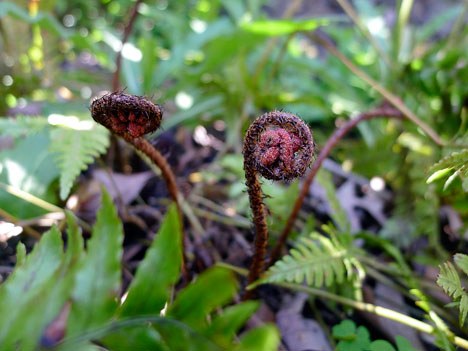
they are quite beautiful, almost reptilian. when they open they are orangey-red, having the opposite color cycle of a green fern. in spring and early summer they flame as brightly as a maple tree. then toward fall, they begin to fade to green and they retain a bright green color most of the winter, finally dying back completely in early spring.

i often miss this stage of their emergence, because they blend so well with rotting leaves and dirt. i’m glad i got some nice photos this time . . .
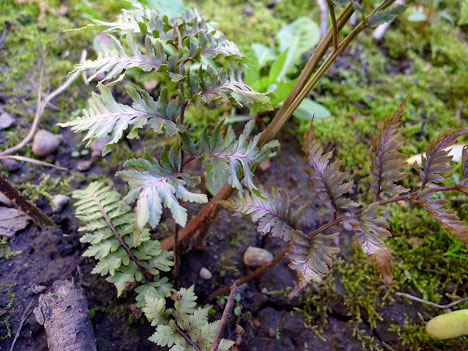
the painted ferns are the early birds of the bunch, having opened a couple of weeks back. i love their veriegated colors; each stem is slightly different and each plant as well.
in my absence, david has taken up the spade to get the dirt turned in the existing vegetable patch and to work on turning yet another section of our lawn into planting space.
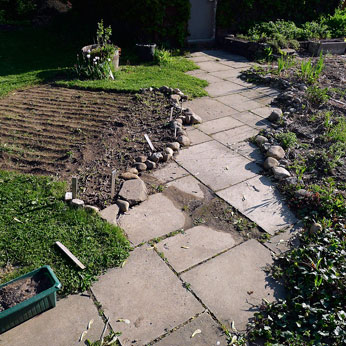
we’re charting new territory on the other side of the path, where i had begun a small patch for greens and herbs. if we had our druthers, we’d dig up the whole yard to dispense with the grass entirely in favor of more space for vegetables and flowers.
but since we don’t have enough topsoil for that yet, we’re doing it one piece at a time (this is also a good way to find out what our limit will be for taking care of it all). you can see where david marked out the perimeter of the new planting area—it will extend from the back door all the way to the garage.
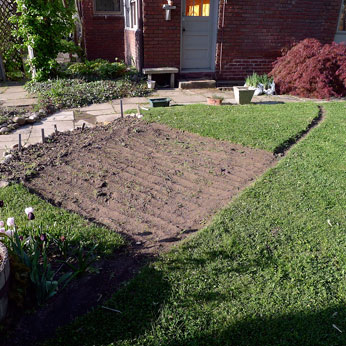
he’s scraping the sod off the top first. this gets carted off to the compost pit, which takes up a very large area behind our garage.
taking care of the compost pit is one of david’s ongoing projects; it was there when we moved in but hadn’t been attended to in years. when we saw how many bags of leaves we filled each spring and fall (over forty, each season), we decided to invest in a shredder in order not to send all that to the dump. now, he piles up all the shredded yard debris over the course of the year and turns the whole shebang maybe once or twice.
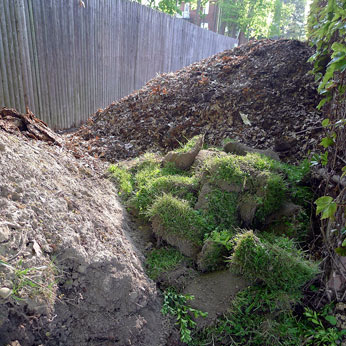
the older stuff gets buried under newly added stuff (see the height of that back pile?), where it begins to cook from being trapped and heated by the sun. the cooking produces gaseous emissions, which encourages faster rotting and breakdown of the material. also, it’s a worm magnet, so there are droves of them in there, churning away and adding worm manure. if you dig into the mountain, you can feel and measure the heat of the cooking plant matter; it’s pretty impressive—david quickly learned to save the turning work for chilly spring and fall days.
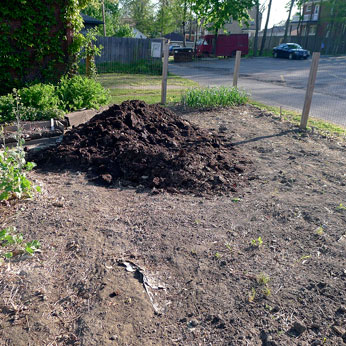
eventually, this is what comes out the bottom of the pile—black gold. we work this into our soil whenever we create a new planting area or when an older bed needs topping off. we also share with our neighbors and some of them are kind enough to pitch in on helping david turn the compost (we’ve probably got fifteen or twenty yards of it at any one time).
i haven’t decided yet what to put in the new planting bed—i’m not sure if one type of crop is better than another for a new area, but i have about two more weeks to think about it before planting time. i was thinking that root vegetables might be good there—they’d provide pretty vines on the street side. but chard is pretty, too . . .
well, i’m done for now—you have a good weekend and i’ll be back probably tuesday. i heard that erica has an update on her sock project which she’ll be posting between now and then.

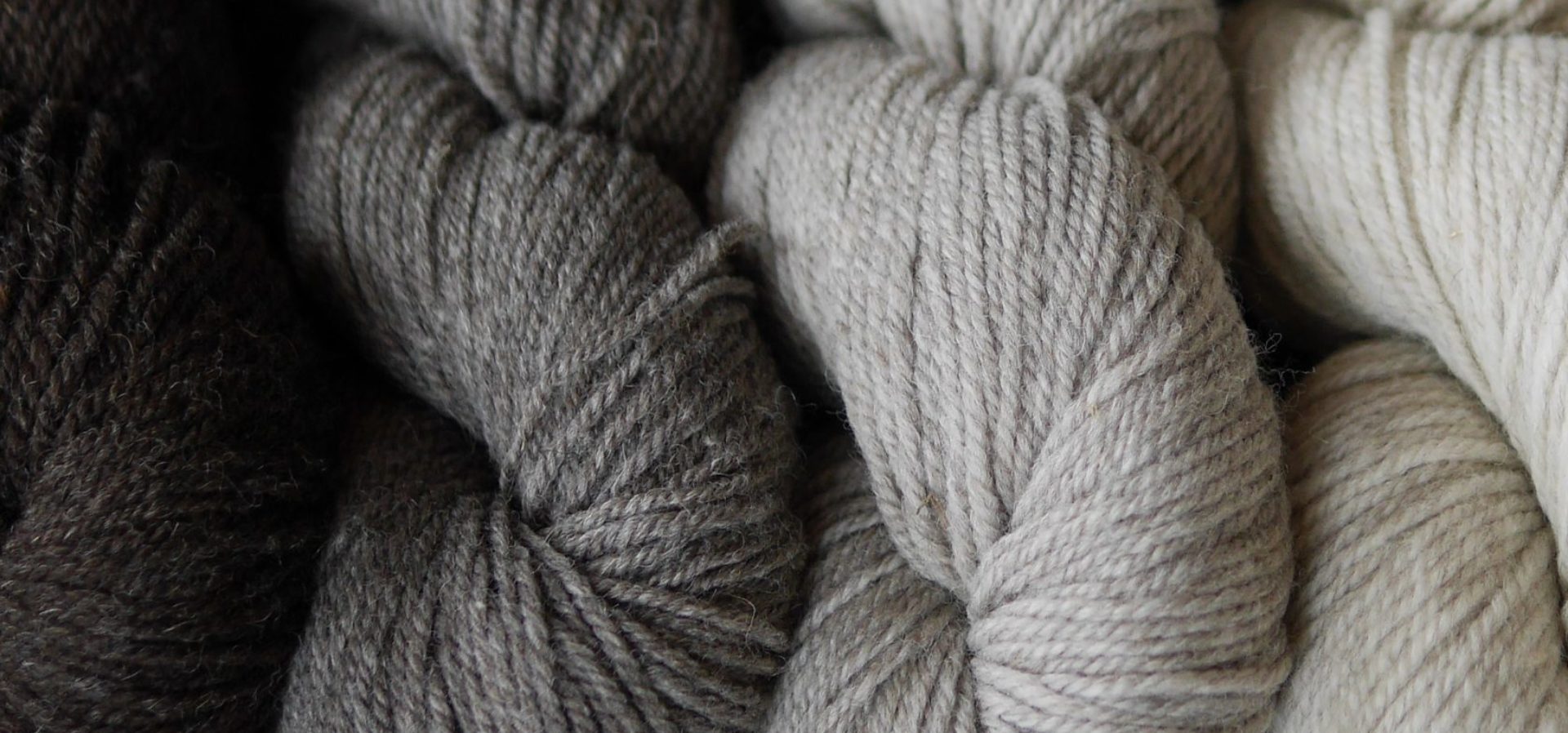
19 thoughts on “green renovation”
I’ve been out looking for the the beginnings of fiddleheads too they are good eating around here. Kinda like a cross between asparagus and spinach.
Potatoes are really good for a new area – they help to break up the soil ready for other things the following year. I learned that from the old hands on the allotment 🙂
Very impressive compost!! I’m with you, less grass, more gardening space.
Ymmmm, chard. I just discovered chard this past winter and I love it. I bet it’s wonderful fresh out of a garden.
what a refreshing way to start my day…reading your post! every picture made me smile. the colors of the vegetation are fantastic! i think the robin’s nest would be adorable in a frame.
happy travels to you!
I love all your gardening photos and the tips and ideas I pick up from you along the way. I’m working on turning more and more of my grass into planting spaces. let’s ignore how i actually replaced a bed with grass the first year i was here. 😉 I just have to gain the courage to plant more edibles in the front!
I’m researching leaf shredders since due to wind patterns (i think) i get not only all our leaves, but also many of the leaves my neighbors silly landscapers blow to the curb. i’m not complaining too much (they all use icky chemicals to have perfectly green and even golf courses so i’m trying not to think too much about that),
but since i haven’t shredded any of my leaves, i mostly have a leaf pile instead of a compost pile. What leaf shredder do you have? does it also do small branches?
I am envious of all your ferns!
let me be the first to fully enable you to replace grass with lilies of the valley. oh man, the sight/smell would be incredible. 🙂
What a huge compost pile! Do you put other things in your compost pile, or just leaves?
Another thought about the sod: in the early fall, turn it over on site – can literally do cut-scrape a chunk-flip it over – cover really well with newspapers (3 or more sheets) then some of the “extra” compost from the back yard to weight the newspaper down and leave it be. In spring, it should be rotted down enough to plant in. My Horti cousin built all her beds doing this – started at the outside edge of her property and now has no grass left and a beautiful perennial garden with some gravel paths.
Actually, I think “snails on a stick” is a perfect description.
The garden pictures are always so beautiful. Love them.
that compost pile rocks! It’s huge! Someday, when we’re all grown up and have our own house, I totally plan on sacrificeing a large portion of the grass to garden. I think it would be so cool to have a whole fornt yard as garden with a back yard for playing in for the kids. lots of gaden-envy! 🙂
I love Lily of the Valley and it’s blooming here now. More than any flower, reminds me of the Flower Fairies. We even had a Flower Fairy costume book!
I think the ferns are really magical as they uncurl themselves.
I love reading about your garden as it’s always so inspirational.
I am voting for rhubarb in the new street facing bed 🙂 it is sculptural & scrummy in the tummy.
Deep rooting crops like potatoes are recommeded for developing new plots also anything in the pea family as it fixes nitrogen in the soil, especially if you dig the vines back in.
take care
megan Leslie
You could always use perennial vegetables, herbs and berries in your beds, and make it look decorative as well! There is a whole book about edible landscaping, by Rosalind Creasy, who I love as an author. You could plant things like rhubarb, sorrel, walking onions, shallots (which aren’t perennials, but you can leave a few in the ground to make more next year) strawberries, blueberries (they have miniature and dwarf varieties) and currants, which grow to 3-4 ft, but you can keeps smaller if you prune them. ) My mom grows a type of wild kale that reseeds itself, and you can eat the unopened flowers like broccoli rabe.
Can you tell I wish I had more time in my gardens?!
your lilies of the valley are quite beautiful. they always remind me of my grandmother. she grew them under her grape arbor in her backyard. and she taught me a song about them, called white coral bells. or maybe it is white choral bells…
unfortunately for me, it is a plant that just does not fare well in california.
Comments are closed.